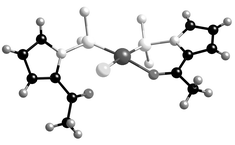Synthesis and reactivity of rhodium(i) complexes containing keto-functionalised N-pyrrolyl phosphine ligands
Abstract
The reaction of [Rh(μ-Cl)(CO)2]2 with two equivalents of L [L = PR2{NC4H3C(O)Me-2}; R = Ph, L1; R = NC4H4, L2] gave the P,O-chelate complexes [RhCl(CO)(L-κ2P,O)] (1, L = L1; 2, L = L2), whereas reaction with four equivalents of L gave [RhCl(CO)(L)2] (3, L = L1; 4, L = L2). Complexes 3 and 4 are fluxional in solution, and at low temperatures exist predominantly with one of the two keto groups coordinated. Complexes 3 and 4 undergo metal-promoted hydrolysis reactions with adventitious water leading to the diphosphoxane-bridged dimers [RhCl(CO)(μ-PR2OPR2)]2 (5, R = Ph; 6, R = NC4H4), with the carbonyl and chloride ligands both terminal and semi-bridging in 5 but solely terminal in 6. Complexes 3 and 4 react with NH4PF6 or TlPF6 to give cis-[Rh(L-κ2P,O)2]PF6 (7b, L = L1; 8, L = L2). These complexes are also formed from the reaction of L with [Rh(μ-Cl)(cod)]2 in the presence of NH4PF6. Complex 8 reacts with CO to give [Rh(CO)(L2)2]PF69, with PMe3 to give [Rh(PMe3)2(L2-κ2P,O)]PF610, and with [NEt3Bz]Cl (Bz = CH2Ph) to give [RhCl(L2-κ1P)(L2-κ2P,O)] 11. Complexes 2, 5·CH2Cl2, 6·C7H8, 7b, 8 and 11 have been crystallographically characterised. The electron-withdrawing character of L1 and L2 has led to differences in reactivity from the β-ketophosphine PPh2CH2C(O)Ph and the ether-phosphine PPh2CH2CH2OMe.


 Please wait while we load your content...
Please wait while we load your content...